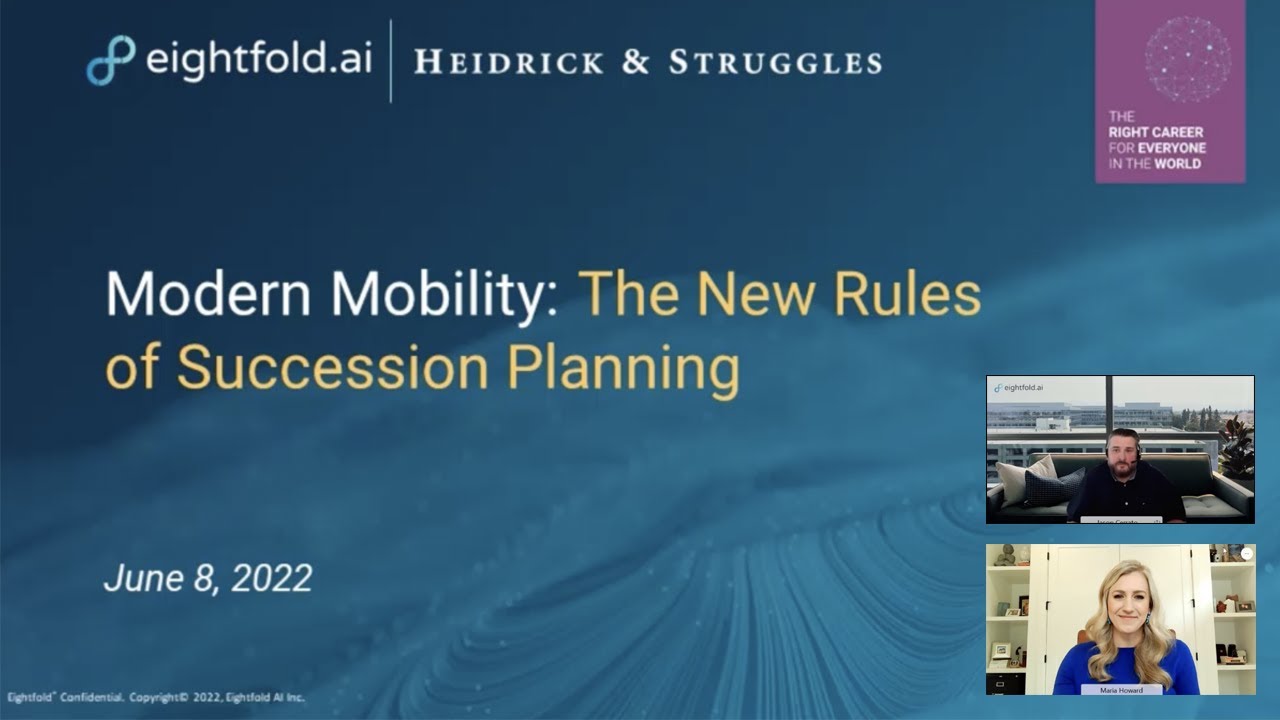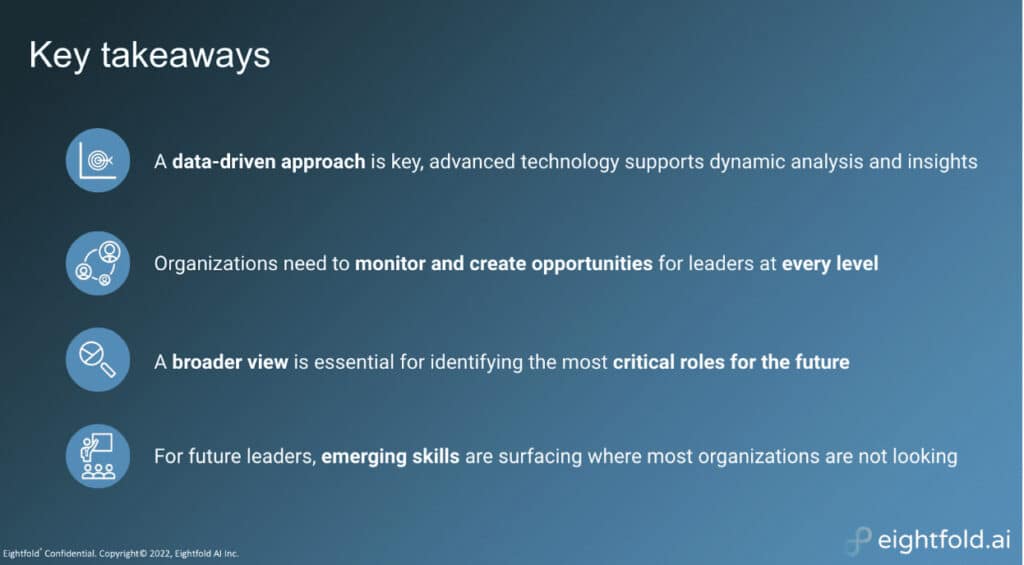- More than half of organizations don’t have formal succession planning for their executives, a recent Heidrick & Struggles survey shows
- Only 22 percent of HR leaders in that same survey describe their companies as having industry-leading effectiveness at identifying and placing senior leaders
- And almost three-quarters expect at least some of their leadership roles will change significantly in three to five years
The biggest threat to succession planning is uncertainty. Organizations are faced with uncertainty today in every direction. We have a war going on. We’re still trying to come out of this pandemic. There’s the economy for good and bad. If you work in talent, you are probably familiar with hurry up and stop.
– Jason Cerrato, Senior Director of Product Marketing, Eightfold AI
When talent leaders hear “succession planning,” they probably cringe a little bit. After all, succession planning in any organization is traditionally one of the most time-consuming, expensive, and manual parts of the talent management process.
A recent Heidrick & Struggles survey of HR leaders suggests that as many as 30 to 50 percent of companies have no formal detailed succession plan for the CEO.
It doesn’t have to be that way.
In our latest webinar, “Modern Mobility: The New Rules of Succession Planning,” Eightfold AI’s Jason Cerrato, Senior Director of Product Marketing, and Maria Howard, Partner and General Manager, Heidrick Digital, discuss what’s most impacting HR leaders now in succession planning — and how to rethink processes and overcome challenges to get ahead.

Here’s what every talent leader needs to know to build an agile succession plan.
Succession planning needs to be agile and always-on, not ad hoc
While everyone has been talking about agility in their talent approach for a while, it’s not put into practice enough. Succession planning is often one of the toughest — and most neglected — areas that has a need for speed.
Nearly 41 percent of webinar poll respondents said they relied on manual processes when it comes to succession planning.
Additionally, 44 percent of respondents said that succession planning is part of their annual process, while 25 percent say they do it on an as-needed basis.
Succession planning can often take months of work and many people — not to mention money — to get done. Traditional methods don’t scale well. HR leaders need an always-ready plan to replace any essential employee, especially leaders, quickly.
Today’s accelerated pace of change requires a new strategy. There’s more data available than ever before and it’s growing exponentially. People alone cannot keep up.
To stay competitive, this process must be augmented with talent intelligence and AI.
Data can help any HR team understand what to focus on next and inform those decisions. And help them do it fast and right.
Cerrato says to think of tech and data as an insurance policy. This information pipeline on succession planning is always-on, supporting a continuous digital approach.
A skills-focused strategy is an absolute must
Many organizations are shifting their approaches to focus on skills and not roles when hiring. This is a solid strategy when it comes to succession planning.
Eightfold AI just conducted a Talent Survey of over 250 HR leaders and nearly 1,000 employees. At a top level, HR executives are juggling skill development and identifying leaders. How they analyze their talent and democratize the process to promotion will be essential to their success.
By looking at high-level skills, HR leaders can see what is needed for roles. By matching skills to roles they are increasing the talent pool for succession planning and opening the door for current employees to move up. They’ll also have to incorporate training for new skills, including leadership training and development, to nurture their pipelines.
To do so, HR leaders need to balance what’s going on inside the organization with market intelligence and know the declining and emerging skills specific to their industry. Tomorrow’s leadership roles will require different sets of responsibilities and skills that pull from a broader mix of experiences, opening the door to people who may not have taken traditional career paths.
In fact, at least 18 percent of organizations expect half or more of their leadership roles will change significantly in three to five years, according to Heidrick & Struggles data.
“Now we’re seeing CEOs emerge who were chief strategy officers, chief transformation officers, maybe even a chief risk officer, and coming from technology and IT as well,” Howard said.
Howard shared the four capabilities that all future leaders should have. One, they’ll need to be a connector who leads through influence and inclusivity. Two, they have to be great at driving execution and making decisions on complex and new challenges. Responsibility comes next, as modern leaders need to consider their people, profits, and the planet. Finally, they need to implement a new way of thinking about work and have a future-focused ownership mindset.
Find the people who can rise to those challenges. They might be a potential future leader.
Deepening the talent bench: The seven-layer ceo question
Once you’ve found a few great people to nurture and develop their skills, it’s time to go deeper.
Howard shared a story about a colleague asking a CEO who the next CEO would be in their organization.
“The answer was what you’d expect, right?” Howard said. “Various C-Suite members or VP-level people. But this person said to the CEO, ‘That’s not what I’m asking you. Who are the next seven CEOs down in your organization, go seven layers down. Do you know who they could be?’ ”
The organizations that can identify their prospective leaders earlier are more likely to be industry leaders in the future. Heidrick Digital’s research found that only 22 percent of HR leaders say their companies have industry-leading effectiveness at identifying and placing senior leaders.
To find that hidden talent earlier, HR leaders must give employees more visibility and transparency into the talent process. Going deeper into an organization for succession planning keeps talent pipelines humming, but also keeps people in the driver’s seat of their careers, encouraging those superstars of tomorrow.
“Give people a chance to allow for leadership to develop and surface at every level,” Cerrato said. “Maybe it’s not your next seven CEOs, but at the end of the day, HR is tasked with incorporating more data into these processes and doing it more frequently and not solely relying on their own data or who is in their immediate proximity. It’s now more ‘who do we have?’ and democratizing the opportunity.”
4 takeaways for succession planning

Succession planning can become an integrated—and doable—part of any talent management strategy. Here are our four takeaways to help HR teams better prepare for the future.
Organizations must take a data-driven approach. Advanced technology can support dynamic analysis and insights, and incorporating additional data and market intelligence is essential to get the full picture.
Organizations need to monitor and create opportunities for leaders at every level. Creating a talent management system where everyone can be actively involved in career pathing benefits everyone.
A broader view of the organization and industry as a whole are essential for identifying the most critical roles for the future.
Finally, emerging skills are surfacing throughout organizations where HR teams are most likely not looking with succession planning. As leadership roles change faster, HR needs deeper visibility into those skills within the organization to plan for and develop those people. According to our webinar poll, most organizations said that they only review down to the senior executive level.
With these takeaways and practices in mind, succession planning should become a more fluid and integrated part of any organization’s overall talent strategy.
For more on succession planning, watch our webinar “Modern Mobility: The New Rules of Succession Planning.”










